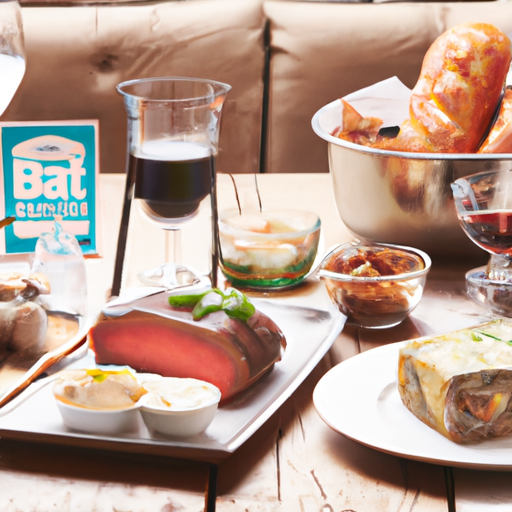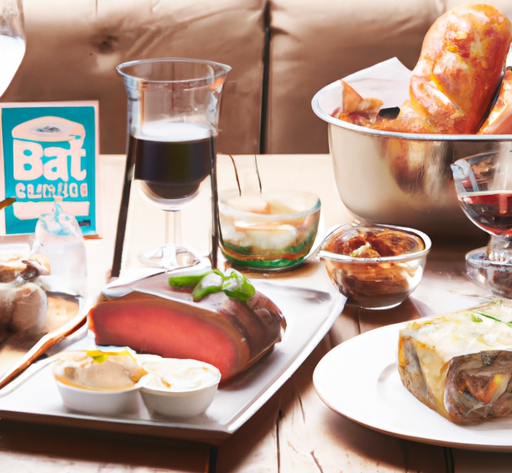Welcome! Today we will be discussing delicious food and wine pairings. In this article, you will learn how to enhance your dining experience by matching the right food with the perfect wine. Whether you are a foodie or a wine enthusiast, this guide will give you some exciting ideas to explore.
When it comes to food and wine pairing, the options are endless. From classic combinations like steak and red wine to more exotic pairings like sushi and sake, there are no limits to the culinary delights you can create. This article will delve into the world of food and wine, and provide you with tips and tricks to ensure a harmonious marriage between flavors. So sit back, relax, and get ready to tantalize your taste buds with these delightful pairings.
Delicious Food and Wine Pairings
Are you a culinary enthusiast who loves to explore new flavors and indulge in the best of both worlds – food and wine? If so, you’ve come to the right place. In this article, we will dive into the art of pairing food and wine to create unforgettable dining experiences. From understanding the basics to exploring different types of wine, we will guide you through the process of identifying flavor profiles and offer a range of pairing suggestions. So grab a glass, sit back, and let’s embark on this delicious journey together.
Understanding the Basics
Before we delve into the intricate details of food and wine pairing, it’s essential to grasp the basic principles. First and foremost, it’s important to note that there are no hard and fast rules. Every palate is unique, and what may be a perfect pairing for one person might not necessarily be the case for another. However, there are guidelines that can help you navigate the world of pairing with confidence.
When it comes to food and wine pairing, intensity is key. Consider the overall strength of the flavors in both the dish and the wine. Aim to match equally intense flavors to ensure a harmonious balance. Additionally, take into account the acidity and sweetness levels. A wine with high acidity can help cut through rich and fatty foods, while a sweeter wine can complement spicy dishes. Finally, don’t forget to balance the texture and weight of the food and wine. A lighter wine usually pairs well with delicate dishes, while heavier wines can handle heartier fare.
Exploring Different Types of Wine
To create the perfect pairing, it’s crucial to have a basic understanding of different types of wine. Let’s take a brief journey through the world of wine, from bold reds to refreshing whites and everything in between.
Red wine, known for its robust flavors and deep colors, is a popular choice when it comes to pairing with rich meats. Cabernet Sauvignon, Malbec, and Syrah are excellent choices to accompany dishes such as steaks, lamb chops, and game meats. However, don’t overlook lighter reds such as Pinot Noir, which pairs beautifully with poultry and fish dishes.
On the other side of the spectrum, we have white wine, known for its crispness and lightness. Crisp whites like Sauvignon Blanc and Pinot Grigio are the perfect companions for seafood dishes, enhancing their delicate flavors. For creamier dishes, opt for a full-bodied white such as Chardonnay. If you’re craving a little spice, off-dry whites like Gewürztraminer or Riesling can complement spicy cuisine beautifully.
Rosé wine, with its lovely pink hue, has become increasingly popular in recent years. Dry rosé pairs wonderfully with light fare such as salads, grilled veggies, and fresh cheeses. For those with a sweet tooth, sweeter rosés make a delightful pairing with fruity desserts. Rosé also lends itself well to various international cuisines, making it a versatile choice for a wide range of dishes.
Last but certainly not least, we have the effervescent world of sparkling wine. Brut Champagne, with its crisp and lively bubbles, is a classic choice for pairing with shellfish. Prosecco, a sparkling wine from Italy, is a fantastic option when serving appetizers. Sparkling wine, with its celebratory nature, can also be a fun addition to party foods, elevating the overall experience.
Identifying Flavor Profiles
Now that we have explored different types of wine, it’s time to dive deeper into flavor profiles. Understanding the key characteristics of food and wine can help you create harmonious pairings that enhance the overall dining experience.
Bold red wines, such as Cabernet Sauvignon and Syrah, typically exhibit flavors of dark fruits, like blackberries and plums, along with hints of oak and spice. These wines can handle rich and intense meats like beef, venison, and lamb. The tannins present in bold reds help cut through the richness of the meats, creating a delightful contrast of flavors.
Lighter red wines, such as Pinot Noir, showcase brighter fruit notes like cherries and raspberries, along with earthy undertones. These wines pair beautifully with poultry and fish dishes, as they won’t overpower the delicate flavors. Think roasted chicken, grilled salmon, or even a mushroom risotto.
Crisp white wines, like Sauvignon Blanc and Pinot Grigio, are known for their citrusy and herbaceous flavors. These wines work wonders with seafood dishes, accentuating the freshness of the fish. Imagine a plate of grilled shrimp or a serving of oysters on the half shell paired with a chilled glass of Sauvignon Blanc – pure bliss.
Full-bodied white wines, such as Chardonnay, offer a rich and creamy mouthfeel with flavors of tropical fruits and buttery notes. These wines are perfect when paired with creamy and indulgent dishes such as lobster bisque, buttery pasta, or a decadent risotto.
Off-dry white wines, like Gewürztraminer and Riesling, possess a hint of sweetness that complements spicy cuisine. The slight sweetness helps to balance and tame the heat, offering a delightful juxtaposition of flavors. Thai curry, Indian biryani, or even a plate of spicy tacos pair beautifully with off-dry whites.
Dry rosé wines, with their vibrant and refreshing flavors, are incredibly versatile when it comes to pairing. Lighter rosés are the perfect match for salads, light pastas, or grilled vegetables. Sweeter rosés, with their fruity notes, bring out the best in fruity desserts like summer berry tarts or peach cobbler.
Sparkling wines, with their lively bubbles and crisp acidity, bring a festive touch to any meal. Brut Champagne is a natural choice when serving shellfish, with the bubbles cleansing the palate after each decadent bite. Prosecco, with its fruit-forward and approachable nature, pairs beautifully with appetizers like bruschetta, prosciutto-wrapped melon, or creamy cheeses. And let’s not forget that sparkling wine adds an extra sparkle to any party food, making it the ideal choice for celebrations.
Regional Food and Wine Pairings
When exploring the world of food and wine pairing, it’s impossible to overlook the culinary traditions of various regions. Let’s take a moment to appreciate some of the iconic pairings that have stood the test of time.
Italian cuisine is renowned for its rich flavors and vibrant ingredients. When it comes to pairing Italian dishes, it’s all about finding wines that enhance the flavors without overpowering them. For classic pasta dishes like spaghetti carbonara or fettuccine Alfredo, a crisp white wine like Pinot Grigio is a fantastic choice. If you’re indulging in a hearty plate of osso buco or rich lasagna, a bold red like Chianti or Barolo will beautifully complement the flavors.
French cuisine, known for its elegance and sophistication, offers a wide range of pairing opportunities. When serving coq au vin or beef bourguignon, a red Burgundy wine is the perfect choice. The earthiness of the wine harmonizes with the depth of flavors in the dishes. For lighter fare like quiche Lorraine or a fresh salad niçoise, a crisp white wine from the Loire Valley, such as Sancerre or Pouilly-Fumé, will elevate the flavors.
Spanish delights, with their bold and robust flavors, call for equally adventurous wine pairings. When serving classic paella, a fruity and lively Rioja is an excellent choice. The vibrant flavors of the wine complement the range of ingredients in the paella, from the seafood to the saffron-infused rice. For tapas like patatas bravas or chorizo al vino, a glass of Tempranillo brings out the best in these flavorful bites.
Exploring Unique Pairings
While sticking to traditional pairings can be a safe bet, sometimes it’s rewarding to step out of your culinary comfort zone and explore unexpected matches. Here are a few unconventional pairings that might surprise you:
-
Sushi and Grüner Veltliner: The light and refreshing notes of Grüner Veltliner, a white wine from Austria, complement the delicate flavors of sushi remarkably well. Give it a try and indulge in a sushi and wine pairing that will take your tastebuds on an unexpected journey.
-
Barbecue and Zinfandel: When it comes to smoky and spicy barbecue dishes, Zinfandel is the perfect partner. The bold flavors of the wine stand up to the richness of the barbecue sauce, creating a mouthwatering combination.
-
Dark Chocolate and Cabernet Sauvignon: For those with a sweet tooth, a square of dark chocolate paired with a glass of Cabernet Sauvignon can be an absolute delight. The deep, fruity notes of the wine play off the bittersweet flavors of the chocolate, creating a memorable pairing.
Fusion Cuisine and Wine Pairings
As the culinary landscape becomes increasingly diverse, fusion cuisine has gained popularity. Combining elements from various culinary traditions, fusion dishes are a delightful playground for adventurous food and wine pairings. Whether it’s a fusion of Asian and Latin American flavors or an unexpected marriage of Mediterranean and Middle Eastern cuisines, the possibilities are endless.
When experimenting with fusion cuisine, it’s essential to consider the dominant flavors of the dish. For dishes with a strong Asian influence, such as sushi burritos or Korean tacos, consider pairing them with a crisp and aromatic white wine like Riesling or Gewürztraminer. The lively acidity of the wine can harmonize with the vibrant flavors of the dish.
For dishes with a Middle Eastern or Mediterranean twist, like lamb tagine or falafel sliders, opt for a medium-bodied red wine like Syrah or Grenache. The earthiness of the wine can complement the spices and herbs, enhancing the overall dining experience.
Decoding Wine Labels
Now that you have explored the world of food and wine pairing, let’s take a moment to decode some of the mysteries behind wine labels. Understanding wine varietals, regions, and descriptors can empower you to make informed choices and discover new favorites.
Wine varietals refer to the specific type of grape used to produce the wine. Varietals such as Cabernet Sauvignon, Chardonnay, and Pinot Noir are well-known examples. Each varietal has its own unique characteristics, from flavor profiles to aging potential.
Regions play a crucial role in the world of wine. Different regions have distinct climates, soils, and winemaking traditions, all of which contribute to the flavors and characteristics of the wine. Exploring wines from different regions can introduce you to a world of diversity and complexity.
Wine descriptors are the words used to describe the various elements of a wine. Descriptors can include terms such as fruity, oaky, earthy, or floral. These descriptors help paint a picture of what to expect when tasting a particular wine, allowing you to make an educated choice based on your preferences.
Reading and analyzing wine labels can be a fascinating journey of discovery. Take the time to explore and experiment with different varietals, regions, and descriptors, and you’ll constantly find yourself uncovering new and exciting wines.

Conclusion
Congratulations, you have completed your crash course in the art of pairing food and wine! Armed with the knowledge of the basics, the exploration of different types of wine, and the understanding of flavor profiles, you are now equipped to embark on your own culinary adventures. Whether you stick to classic pairings or venture into uncharted territories, remember that the ultimate goal is to create memorable experiences that engage all your senses. So gather your favorite dishes, pour a glass of wine, and savor the journey of delicious food and wine pairings. Cheers!




